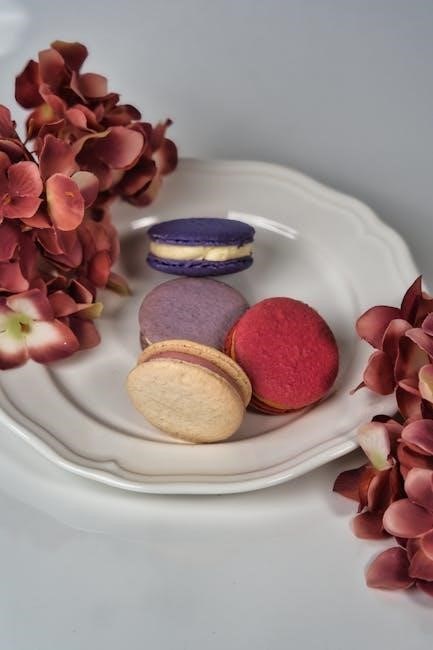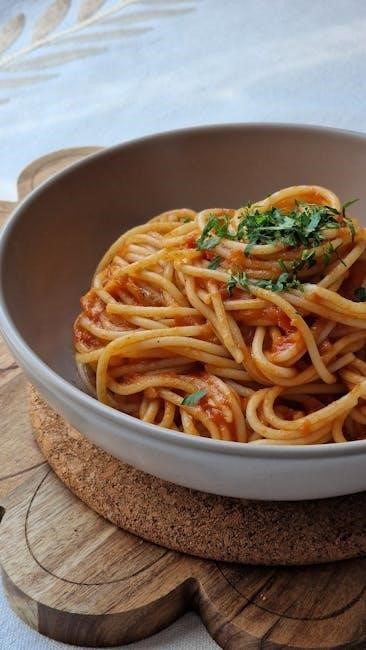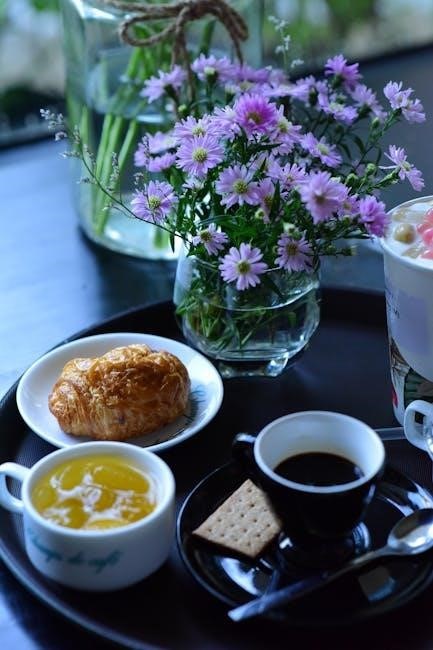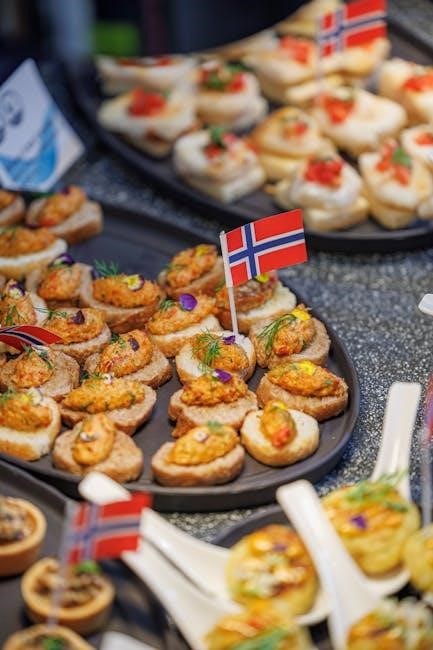
Modernist Cuisine, released in 2011, revolutionizes cooking by blending science and culinary art. This multi-volume book, by Nathan Myhrvold and team, offers detailed techniques, tools, and recipes, transforming home and professional cooking.
Overview of the Book
Modernist Cuisine: The Art and Science of Cooking is a groundbreaking, six-volume cookbook that redefines culinary practices by merging science, technique, and creativity. Authored by Nathan Myhrvold, Chris Young, and Maxime Bilet, the book spans over 2,400 pages, offering an exhaustive exploration of modern cooking. First released in 2011, it has become a benchmark for both professional chefs and home cooks. The book introduces innovative tools, such as sous vide machines and 3D food printers, and explores scientific principles like emulsification and spherification. It also delves into food safety, ingredient preparation, and the history of culinary techniques. The authors used cutting-edge technology, including electron microscopes, to create visually stunning and informative content. With over 1,500 recipes and detailed photographs, Modernist Cuisine is a comprehensive guide that bridges the gap between art and science in cooking, making it a must-have for culinary enthusiasts worldwide.
Authors and Their Contributions
Nathan Myhrvold, a renowned chef, scientist, and former Microsoft CTO, is the primary author of Modernist Cuisine. His unique blend of culinary passion and scientific expertise laid the foundation for the book. Chris Young, a skilled chef and food scientist, contributed significantly to the development of modernist techniques, while Maxime Bilet, a classically trained chef, brought creativity and precision to the project. Together, they formed a team of chefs and scientists who spent years researching and experimenting, resulting in a revolutionary cookbook. Their work introduced innovative methods and tools, such as sous vide and foamification, to the culinary world. The authors’ collaborative effort has not only advanced professional cooking but also made modernist techniques accessible to home cooks through subsequent books like Modernist Cuisine at Home.

Key Concepts and Techniques
Modernist Cuisine introduces groundbreaking techniques like sous vide, spherification, and foamification, leveraging science to transform ingredients and enhance flavors. These methods redefine traditional cooking, offering precise control and innovation.
Scientific Principles Behind Modernist Cooking
Modernist cooking relies on understanding the chemical and physical transformations in ingredients. Techniques like sous vide utilize precise temperature control to ensure even cooking. Spherification and foamification exploit gelification and emulsification, using ingredients like sodium alginate and lecithin. These methods are rooted in molecular gastronomy, where science explains how heat, pH, and enzymes affect food. The Maillard reaction, a chemical process, enhances flavors and textures. By applying principles like diffusion and phase transitions, Modernist Cuisine unlocks new culinary possibilities, making complex dishes achievable for both professionals and home cooks. This approach bridges the gap between science and cooking, offering innovative ways to prepare and present food. The use of tools like vacuum sealers and thermomixers further underscores the role of technology in modernist techniques. These scientific foundations redefine traditional cooking, creating a new era of gastronomic exploration.
Essential Tools and Equipment
Modernist cooking requires specialized tools to achieve its innovative results. A sous vide water bath is indispensable for precise temperature control, ensuring even cooking. A vacuum sealer is essential for sealing ingredients airtight, preventing oxidation and flavor loss. High-speed blenders and food processors are used to create smooth purees and emulsions. Thermomixers and immersion circulators allow for exact temperature management and consistent heating. Other key tools include anti-griddles for freezing and smokers for infusing flavors. Digital thermometers and pH meters aid in monitoring cooking conditions. These tools, often unconventional in traditional kitchens, enable the execution of modernist techniques, making them vital for both professional chefs and adventurous home cooks. Together, they empower creativity and precision in the culinary world.
Modernist Ingredients and Their Applications

Modernist cuisine relies on innovative ingredients to achieve its groundbreaking results. Hydrocolloids like sodium alginate and xanthan gum are used to create unique textures, such as spherified ravioli or stable foams. Transglutaminase, known as “meat glue,” bonds proteins, enabling dishes like meat noodles or hybrid fish steaks; Enzymes, such as papain, break down proteins to tenderize meats or enhance flavors. Curing salts and sodium nitrite are employed for modernist charcuterie, ensuring food safety while creating distinctive textures. Liquid nitrogen and dry ice are used for rapid freezing, adding drama to plating. Foams and airs are crafted using lecithin or soy lecithin, while gellan gum and agar create jiggling, translucent desserts. These ingredients, combined with scientific techniques, redefine culinary possibilities, offering chefs unparalleled creativity and precision in their craft.

Recipes and Preparations
Modernist Cuisine introduces groundbreaking recipes using techniques like spherification and foams. Iconic dishes include spherified ravioli and scallops. Tools like laser thermometers and centrifuges enable precise culinary innovations at home and in professional kitchens.
Signature Dishes from the Book
Modernist Cuisine features iconic dishes like spherified ravioli and caramelized carrot tops, showcasing innovative techniques. The ultrasonic homogenizer and centrifuge enable creations such as foie gras and sous-vide eggs. These dishes blend art and science, inspiring chefs globally to redefine culinary boundaries.
Adapting Modernist Recipes for Home Cooking
Adapting Modernist recipes for home cooking involves simplifying complex techniques and ingredients. Modernist Cuisine at Home offers practical guidance, making high-tech cooking accessible with basic tools like immersion circulators and vacuum sealers. While some recipes require specialized equipment, others can be adapted using everyday kitchen appliances. For instance, sous-vide cooking can be mimicked with a precise water bath, and spherification can be attempted with easily sourced ingredients like sodium alginate. The book emphasizes creativity, encouraging home cooks to experiment and modify recipes based on available resources. This approach ensures that Modernist Cuisine’s innovative spirit is not limited to professional kitchens but can be explored by enthusiasts worldwide, fostering a new wave of culinary experimentation at home. By bridging the gap between advanced techniques and home-friendly methods, Modernist Cuisine inspires chefs of all levels to push creative boundaries.
Impact and Legacy
Modernist Cuisine’s influence revolutionized cooking, inspiring chefs and home cooks. Its legacy continues with Modernist Bread and Modernist Pizza, solidifying its impact on culinary innovation and education worldwide.
Modernist Cuisine at Home
Modernist Cuisine at Home brings cutting-edge culinary techniques to home cooks, offering over 200 innovative recipes. The book demystifies modernist cooking, making it accessible with everyday ingredients and tools. Available as a PDF, it includes detailed instructions for dishes like sous-vide eggs and foam. The companion iPad app enhances the experience, acting as a personal sous chef with interactive guides and videos. This resource bridges professional and home kitchens, inspiring creativity and precision. Its approachable format ensures that anyone can explore modernist cuisine without specialized equipment, fostering a deeper understanding of food science and artistry. With its comprehensive guide, Modernist Cuisine at Home empowers home cooks to experiment and create extraordinary meals, proving that modernist techniques are not just for professionals but for anyone passionate about cooking.
Future Projects and Related Books
Following the success of Modernist Cuisine, the team has expanded its culinary exploration with new projects. Modernist Bread, a comprehensive 5-volume set, delves into the science and history of bread-making. Similarly, Modernist Pizza offers an in-depth look at the art and science of pizza, showcasing techniques for both traditional and innovative creations.
These books continue the tradition of blending culinary expertise with scientific precision, making complex techniques accessible to home cooks and professionals alike. The team’s commitment to rigorous research and experimentation ensures that each publication becomes a benchmark in the culinary world. By exploring diverse topics, they inspire creativity and innovation, pushing the boundaries of what is possible in the kitchen.
Modernist Cuisine has redefined cooking by merging science and creativity, offering a comprehensive guide that transforms culinary practices. Its influence continues to inspire chefs and home cooks worldwide.

Final Thoughts on Modernist Cuisine
Modernist Cuisine is a groundbreaking culinary resource that has reshaped the way we approach cooking. By integrating scientific principles with innovative techniques, it offers unparalleled insights into the art of food preparation. The book’s detailed exploration of ingredients, tools, and methods has made it an indispensable guide for both professional chefs and home cooks. Its influence extends beyond the kitchen, inspiring a new generation of culinary enthusiasts to experiment and innovate. With its comprehensive coverage and revolutionary ideas, Modernist Cuisine stands as a testament to the evolution of cooking, ensuring its legacy as a foundational text in the culinary world for years to come.
